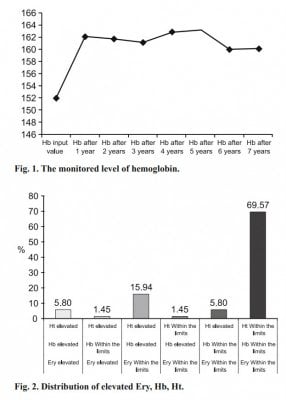Nelson Vergel
Founder, ExcelMale.com
Bratislava Medical Journal Vol.118, No.11, p.654-657, 2017
Title: Testosterone replacement therapy (TRT) and its effect on bone marrow. How serious is it and is there a true polyglobulia?
Author: M. Levcikova, J. Breza Jr, J. Luha, J. Dubravicky, E. Kovacova, J. Fillo
Abstract: INTRODUCTION: TRT in men with testosterone deficiency syndrome (TDS) had multiple positive effects and restore a quality of life of affected men. Polyglobulia is the most common dose-limiting adverse effect of TRT, but the mechanisms of TRT-mediated erythropoesis remain unclear. In this study, we evaluated long term haematological side effects of TRT: polyglobulia, elevated hemoglobin (Hb) and haematocrit (Ht).

METHODS: In a cross-sectional descriptive study, the authors treated 69 men with TDS and the average age 59 years and the follow-up period 81.32 months. The men were treated with three-month i.m. injections of 1000 mg testosterone undecanoate. The elevated values were: Hb above 176 g/l, Ht above 0.52 and erythrocytes (Ery) above 6.0 mil/mcl.
RESULTS: 21 out of 69 patients (30.43 %) had an increased Hb, Ht or Ery during treatment. The interesting fact was that only five men (7.24 %) had increased the number of Ery (true polyglobulia). No men with elevated level of Hb, Ht or Ery had other side effects (like thrombosis).
CONCLUSION: It is still not clear, why in some men on TRT the feedback does not work and bone marrow production of red blood cells continues even if the upper limit is reached. Authors expect that only 7% of men had true polyglobulia, other men had elevated Hb or Ht. Based on our own experience we recommend a regular check of men on TRT on order to avoid possible serious side-effects
Title: Testosterone replacement therapy (TRT) and its effect on bone marrow. How serious is it and is there a true polyglobulia?
Author: M. Levcikova, J. Breza Jr, J. Luha, J. Dubravicky, E. Kovacova, J. Fillo
Abstract: INTRODUCTION: TRT in men with testosterone deficiency syndrome (TDS) had multiple positive effects and restore a quality of life of affected men. Polyglobulia is the most common dose-limiting adverse effect of TRT, but the mechanisms of TRT-mediated erythropoesis remain unclear. In this study, we evaluated long term haematological side effects of TRT: polyglobulia, elevated hemoglobin (Hb) and haematocrit (Ht).

METHODS: In a cross-sectional descriptive study, the authors treated 69 men with TDS and the average age 59 years and the follow-up period 81.32 months. The men were treated with three-month i.m. injections of 1000 mg testosterone undecanoate. The elevated values were: Hb above 176 g/l, Ht above 0.52 and erythrocytes (Ery) above 6.0 mil/mcl.
RESULTS: 21 out of 69 patients (30.43 %) had an increased Hb, Ht or Ery during treatment. The interesting fact was that only five men (7.24 %) had increased the number of Ery (true polyglobulia). No men with elevated level of Hb, Ht or Ery had other side effects (like thrombosis).
CONCLUSION: It is still not clear, why in some men on TRT the feedback does not work and bone marrow production of red blood cells continues even if the upper limit is reached. Authors expect that only 7% of men had true polyglobulia, other men had elevated Hb or Ht. Based on our own experience we recommend a regular check of men on TRT on order to avoid possible serious side-effects
















